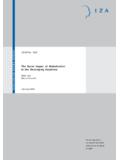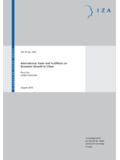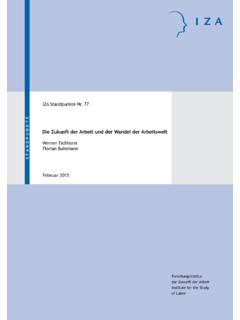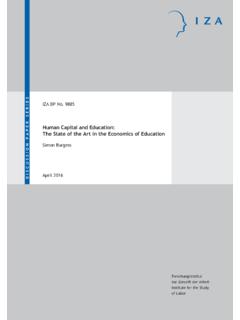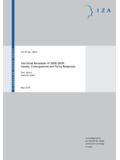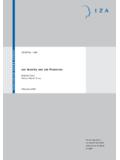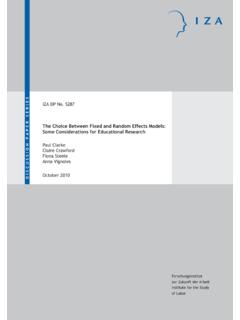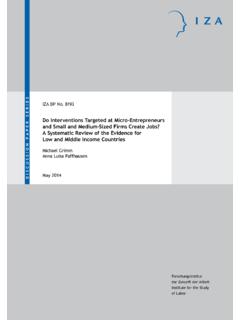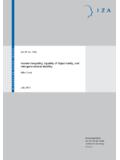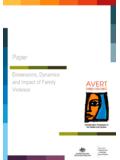Transcription of How Do Marital Status, Wage Rates, and Work Commitment ...
1 DISCUSSION PAPER SERIES. IZA DP No. 1688. How Do Marital Status, wage rates , and work Commitment interact ? Avner Ahituv Robert I. Lerman July 2005. Forschungsinstitut zur Zukunft der Arbeit Institute for the Study of Labor How Do Marital Status, wage rates , and work Commitment interact ? Avner Ahituv University of Haifa Robert I. Lerman American University, Urban Institute and IZA Bonn Discussion Paper No. 1688. July 2005. IZA. Box 7240. 53072 Bonn Germany Phone: +49-228-3894-0. Fax: +49-228-3894-180. Email: Any opinions expressed here are those of the author(s) and not those of the institute. Research disseminated by IZA may include views on policy, but the institute itself takes no institutional policy positions. The Institute for the Study of Labor (IZA) in Bonn is a local and virtual international research center and a place of communication between science, politics and business. IZA is an independent nonprofit company supported by Deutsche Post World Net.
2 The center is associated with the University of Bonn and offers a stimulating research environment through its research networks, research support, and visitors and doctoral programs. IZA engages in (i) original and internationally competitive research in all fields of labor economics, (ii) development of policy concepts, and (iii) dissemination of research results and concepts to the interested public. IZA Discussion Papers often represent preliminary work and are circulated to encourage discussion. Citation of such a paper should account for its provisional character. A revised version may be available directly from the author. IZA Discussion Paper No. 1688. July 2005. ABSTRACT. How Do Marital Status, wage rates , and work Commitment interact ? . How marriage interacts with men's earnings is an important public policy issue, given debates over programs to directly encourage healthy marriages.
3 This paper generates new findings about the earnings-marriage relationship by estimating the linkages between marriage, work Commitment , and wage rates . Unlike other studies of the Marital wage premium for men, we examine how Marital status and Marital transitions affect hours worked as well as wage rates , take account of the feedback effect on wage rates and earnings associated with marriage effects on hours worked, estimate marriage effects on black and low skill men, control for several dimensions of selection, and follow men from age 17-40. We find that marriage increases men's earnings by about 20 percent and also find a rise in wage rates and hours worked increases marriage. These findings suggest that both marriage- enhancing and earnings-enhancing policies can set off a virtuous circle, in which marriage and earnings reinforce each other over time. Unmarried men who appear unable to support a family because of low current earnings are likely to become more adequate breadwinners once they marry.
4 Thus, if proposed programs are able to increase the utility from and appreciation of marriage, they are likely to generate earnings gains for men as an important side effect. JEL Classification: C23, J12, J15, J22, J31, J88. Keywords: labor supply, wage determinants, marriage, Marital dissolution Corresponding author: Robert I. Lerman Urban Institute 2100 M Street, NW. Washington, DC 20037. USA. Email: . The authors are grateful for financial support from the National Institute for Child Health and Human Development, for research assistance by Henry Chen, and for suggestions from David Ribar. The authors also thank the Institute for the Study of Labor (IZA) in Bonn, Germany for hosting them during the preparation of part of this paper. Introduction The decline in marriage and associated two-parent families in the United States continues to complicate efforts to reduce child Recognizing the apparent link between family structures and poverty, policymakers have consistently built family-related provisions into welfare legislation.
5 For example, the 1996 reforms funded teen pregnancy prevention initiatives, strengthened paternity establishment procedures, bolstered child-support enforcement, expanded welfare benefits for two- parent families, and provided single parents with child care. The Bush Administration has proposed a direct intervention to promote healthy Although a primary rationale for the initiative is to improve the life chances of children, a variety of studies suggest increases in healthy marriages may yield other benefits, including better health, lower crime, and reduced domestic violence (Waite and Gallagher 2000; Lerman 2002; and Ribar 2003). This paper concentrates on another potential benefit from marriage the higher earnings of men. This interaction between marriage and earnings is particularly controversial. Some opposing the marriage initiative argue that low-income women do not marry largely because of the dearth of men with jobs and adequate From this perspective, the employment and earnings of men are the key determinant of marriage.
6 An alternative view is that marriage increases employment and earnings partly by stabilizing men's lives, increasing their motivation, and signaling their reliability to employers. 1. The negative association with poverty and inequality is well documented. Single-parent families housed 60 percent of poor persons in families with children, but only 25 percent of all persons in families with children. Families headed by unmarried women accounted for over 70 percent of chronically poor individuals living in families with children. Recent estimates suggest that were marriage rates at levels of the early 1970s, the 1998 US child poverty rate would have been percentage points lower (Thomas and Sawhill 2002), as would income inequality among children (Lerman 1996). 2 For a review of the history leading to this proposal, see Nock (2005). 3. See, for example, the editorial Heartless Marriage Plans from the New York Times,, January 17, A14.
7 1. Determining whether and to what extent marriage is a cause or simply an effect of higher men's earnings is a complex problem. Marriage might alter how much men and women work . Changes in work effort, in turn, influence each partner's accumulation of human capital and wage rates . For those who increase their human capital, higher wages over time makes work more attractive, though the income effect lessens the urgency of long hours. Added work experience and higher wages can increase the likelihood of entering marriage or remarriage and reduce the likelihood of divorce. Marriage may also raise or lower wage rates , by influencing a worker's time horizon, investment, motivation, and acceptance of unpleasant but well-paying jobs. These marriage-induced effects on wages may indirectly lead to an increased work Commitment by men. The literature on these key relationships is extensive and goes back many years.
8 Research confirms an earnings advantage for married men dating back at least to the 19th century (Goldin 1990). Using cross country data from the 1980s, Schoeni (1995) finds a wage advantage of married over single men in all 14 countries studied. The marriage earnings premium estimated from 1940- 1980 decennial Census data has been consistently significant at percentages ranging from +11. percent in 1959 to +23 percent in 1969 (Loh 1996).4 Even among men with poor health, marriage appears to increase hours worked (Parsons 1977). The close associations between Marital status and male earnings have continued through the latest data. Using the March 2004 Current Population Survey (CPS), we estimated standard human capital regressions, expanded to include race, Hispanic origin, and presence of children. Among men, ages 25-49, the coefficient on being married implied a 34 percent earnings advantage over the never-married, a 25 percent advantage over separated men, and a 21 percent advantage over divorced men.
9 These marriage-related differentials are extremely high, about two to three times the 4 These marriage impacts on earnings control for education, years of potential experience, potential experience squared, race, immigrant status, veteran status, region, occupation, and industry. 2. differentials associated with a year of schooling. While these cross-sectional estimates likely overstate marriage effects on earnings because they fail to account for unobserved heterogeneity, they offer a strong motivation for the research trying to isolate the factors underlying marriage-earnings relationship. Several studies have examined the positive association between marriage and earnings, especially the marriage wage premium. 5 Some have looked at the possibility that married men are a select group that would earn high wage rates whether or not they married and avoided divorce. Other studies have analyzed the impact of men's wage rates and earnings on Marital status.
10 But, very few have estimated the effects of Marital status on the Commitment to work or distinguished the marriage-induced gains in hours worked from the induced gains in wage rates . In a companion paper (Ahituv and Lerman 2004), we modeled and estimated the relationships between job stability, Marital stability and wage rates among men. The focus was on young men moving through their 20s and early 30s and how multiple job changes affected wage growth and the transitions to marriage, divorce, and remarriage. Among the key findings were robust negative impacts of job changing on wage rates and on flows into marriage. This paper moves beyond earlier studies in order to estimate the links between marriage, work Commitment , and wage rates . We follow young men from age 17 through their late 30s. We incorporate Marital status effects on hours worked as well as wage rates . We take account of the feedback effect in which marriage affects hours worked, which affect work experience, and ultimately wage rates .
